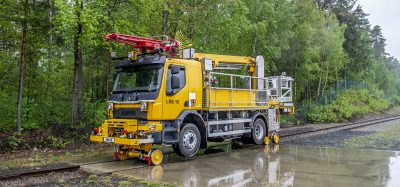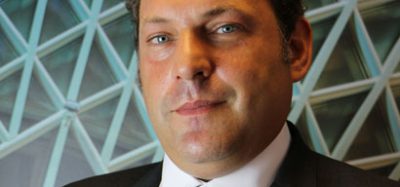The future of rail is here
Posted: 3 April 2006 | | No comments yet
The railway infrastructure market needs excellent, sustainable and economical track solutions – these are the words of Klaus Meusel, Member of the Managing Board, voestalpine Bahnsysteme GmbH & Co KG. However this is not merely commentary; voestalpine Schienen GmbH have invested more than €330m in a new rail manufacturing plant. Craig Waters spoke with Meusel […]
The railway infrastructure market needs excellent, sustainable and economical track solutions – these are the words of Klaus Meusel, Member of the Managing Board, voestalpine Bahnsysteme GmbH & Co KG. However this is not merely commentary; voestalpine Schienen GmbH have invested more than €330m in a new rail manufacturing plant. Craig Waters spoke with Meusel and his colleague Hans Pfeiler, Chairman of the Managing Board, voestalpine Schienen GmbH to find out more.
‘‘Not everybody is fully aware that 21st century rail technology is actually high-tech,” says Hans Pfeiler, “technology is clearly one of the driving forces of voestalpine Schienen: with an excellent team of technical experts and a solid R&D budget, we develop technically – and economically – optimised solutions in the rail system for each load scenario and application.”
With demands on railway infrastructure – and on rails in particular – continuously rising due to even tighter intervals between trains, faster speeds, shorter maintenance times and higher axle loads, Pfeiler expects the intensity of R&D to increase further still. To cope with the challenge, voestalpine have implemented a target-oriented system, based on, for example, the latest findings in the field of rail/wheel contact behaviour.
‘‘Any new product or process has to increase the customer benefit, and consequently due consideration must be given to life cycle cost and RAMS strategies. In this way, we are working closely with leading customers and partners across the world. Practical experiences from the numerous track tests are analysed scientifically and contribute to our new solutions to be offered in the markets.” This approach is well supported by a practice of maintaining excellent customer communication, with technical advice and service teams active all around the world, exchanging information with customers on the spot.
Reaping the rewards
I asked Klaus Meusel what the advantages of their new plant will be, compared with the old facility, and, as importantly, can the improvements be justified against the not-inconsiderable expenditure. His answer was an emphatic “yes”, although the final investment figure is actually the culmination of continued development.
‘‘The most recent investment of €66m was only the final step in a comprehensive long-term program. The target has now been reached: the most modern value-added production chain for rails has become a reality.” Meusel also likes to think of their new facility as “a world benchmark for the creation of customer benefit.”
Turn the clock back to 1990, and the company was already preparing to invest in new mill segments, from the bloom storage up to the finishing area. A cooling bed for the longest weld-free rails in the world (120 metres) has been built, as well as a new generation roller straightening line and a high-tech test centre. In addition, the HSH® (Head Special Hardening) facility is the only installation worldwide that allows in-line fine perlitic head hardening of any rail section up to 120 metres, in any quantity required. Two 24-hour, fully-automated stock yards for ultra-long rails have also been developed, to ensure just-in-time supply to customers.
‘‘The division’s very own blast-oxygen-furnace compact steel mill, adjacent to the rail rolling mill, has been completely refurbished in recent years” says Meusel, “It supplies the highest quality steel to voestalpine Schienen, which forms the basis of outstanding rails.”
A fully-equipped communication centre and a brand-new technology centre have also been created, in preparation for the complete renewal of the rolling line.
‘‘In total, the investment to establish what we believe is the most efficient high-performance and top-quality production plant for rails, amounted to more than €300m. Combined with the product and system know-how of our experts, this certainly constitutes a technological quantum leap for our industry. Thanks only to our customers we have become the largest rail producer in Europe, with the broadest range of different rail sections and the highest share of specialities. With the new rolling mill, increased customer benefit is, more than ever, our primary focus.”
Constructing a new mill is no mean feat. The time scales involved are as impressive as the investment figures and technology itself. Hans Pfeiler picks up the story: “The contract with plant supplier Danieli was signed after a thorough selection process in August 2003. At this time we had already announced that ‘hot commissioning’ of the new rail rolling mill would take place at the beginning of February 2006. Every single step was concluded in accordance with a strict project plan: the tight schedule was more than perfectly fulfilled and I congratulate my staff, who have worked virtually day and night.”
Pfeiler believes the total implementation time of two and a half years is probably a record for such a demanding project, considering all the innovation that has been encompassed. Rail production was interrupted for just two months and this was easily covered by pre-produced rail stocks.
Rails, and only rails
Although increasing capacity was not a decisive factor for investing in a new rail rolling mill, the new capability for just-in-time production means that it is higher than before.
‘‘We will continue to produce more than 100 different rail sections mainly for our European customers,” says Pfeiler, “this includes the most difficult rail sections with a relatively low output per hour. These are often avoided by other manufacturers.” voestalpine Schienen also produce all types of rail on request, in premium grades with specific solutions for each application of the HSH® family. The company takes great pride in the fact that they pay great attention to all facets of rail manufacture: application, profile, length, steel grade, quality, logistics and system know-how. While some competitor companies produce rails as part of a multi-purpose operation together wit products such as beams, voestalpine Schienen are committed to manufacturing rails for specific track solutions. With this policy in mind, comparisons based purely on capacity are pointless.
Pfeiler is confident that market demand will justify the investment from the outset. “We anticipate a rather stable European rail market on one hand, but a higher growth rate in overseas markets where, for instance, our speciality products such as hardened heavy haul rails or grooved rails for tramways are enjoying increased demand. With our new premises and five-day week in operation, we will gradually move from annual production of 350,000 tons, to 400,000 tons annually during the next several years.
A new year and a new mill
Despite repeated upgrades to the old rail rolling line, the decision to completely replace the ‘heart’ of the manufacturing plant had to be made.
‘‘We took this opportunity to shift from the traditional duo rolling technology to state-of-the-art universal rolling technology of the latest generation,” says Pfeiler, “naturally for a technology leading company such as ours, we decided to develop and implement a particularly forward-compatible production system. The objective was to combine high technology with performance, cost-efficiency and flexibility in a manner that would substantially surpass all conventional solutions.”
The old rail rolling line remained in service until the beginning of the main construction phase in December 2005. It was then decommissioned, dismantled and replaced by the new plant.
On January 31 2006, at 20:30 hours, the big moment finally arrived. Ahead of schedule the new rail rolling mill successfully completed its first hot run. The first rails to be produced had a UIC 60/60E1 section and from the start they complied with the tough tolerances demanded.
‘‘We have been gradually increasing output for the last two months and are now passing through the optimisation stage, which includes fine-tuning the processes and stabilisation of the availability.” By the middle of March the new plant had already produced 15,000 tons of rails and, at the time of writing, this volume was expected to double by the end of the month. At the same time, the company is increasing the number of rail sections available for production.
The new plant is packed full with unique innovations, including ultra-flexible rolling (UFR) technology. “This is a world first for rail production,” says Pfeiler, “the roller change takes just 20 minutes, compared with two to three hours in conventional plants. This allows us to introduce just-in-time production and unprecedented flexibility. Other innovative features enable us to further minimise tolerance deviations and improve surface properties. In the area of high-speed rails, for instance, this is of great significance.”
The global context
What does all this investment mean for voestalpine Scheinen’s position on the global stage? Meusel is anxious to put global rail production into perspective: “It is important to remember that rails account for just 0.5-0.6 per cent of world steel production and thus are a comparatively small, but highly demanding, niche segment. The European situation is very similar. However, the global and in particular the European rail market is characterised by fierce competition, which we believe will become even more intense in the future.”
voestalpine customers have given the company a leading position. More than two thirds of production is marketed in Europe and one third is exported overseas. voestalpine supply to virtually all European countries under frame work contracts or on a project basis, including all large markets such as Germany, the UK, France, Italy, Spain, Benelux and Scandinavia. Supplies to the new and future member states of the EU, as well as south east Europe, are increasingly important, subject to availability of funds.
‘‘At a global level, we are witnessing increasing demands from customers operating heavy haul railways in Australia, Latin America and Africa, where they are choosing the best premium rails with extreme resistance to abrasive wear, coupled with convincing life-cycle costs.” Meusel believes there is a global trend towards logistics and service excellence, and a conversion from standard carbon rails to head hardened premium grade rails.
The continuous rise in energy costs and ecological constraints will have an effect on the railway industry in general. “I have no doubt at all that rail transport will continue to form a very important transport mode in the 21st century,” states Meusel, “be it for conventional railways; high speed; heavy haul; light rail and urban rail transport. However, only suppliers with leading and proven customer benefit positions will be able to play significant roles in all these scenarios.”
Voestalpine Schienen GmbH and the other companies of the voestalpine Railway Systems Division are clearly dedicated to bringing new dimensions to customer benefit. The successful commissioning of the most modern rail rolling mill in the world represents another milestone.
Meusel’s closing statement is born out of wisdom and knowledge: “There is a saying: the future of railways is decided at the rail – way, i.e. the track. Let me add that the future of the track is mainly decided by the rail.”







